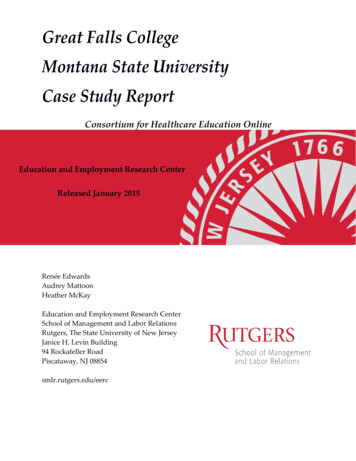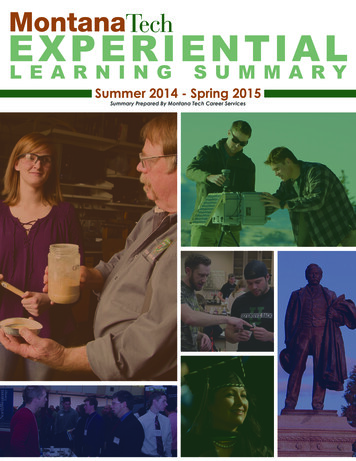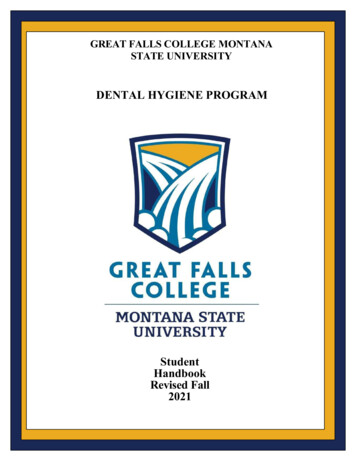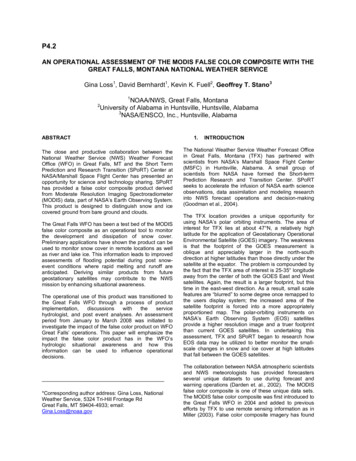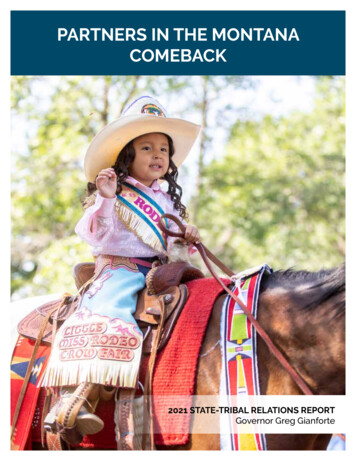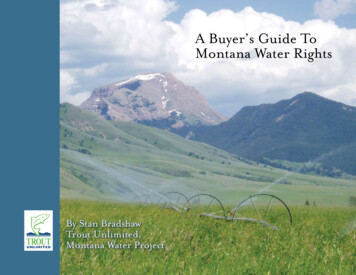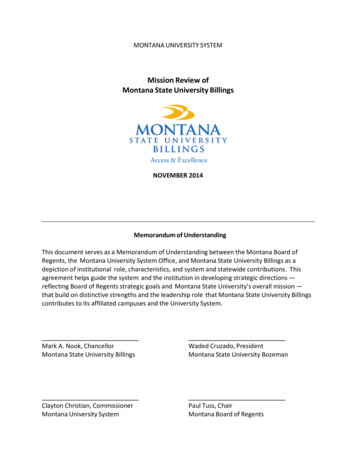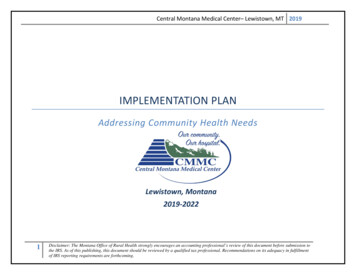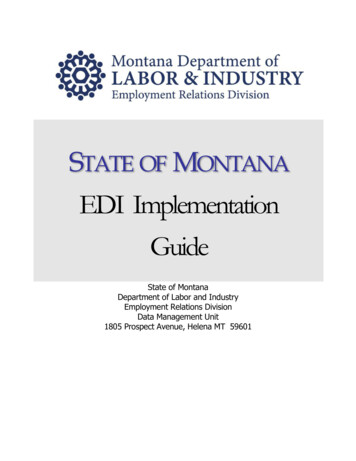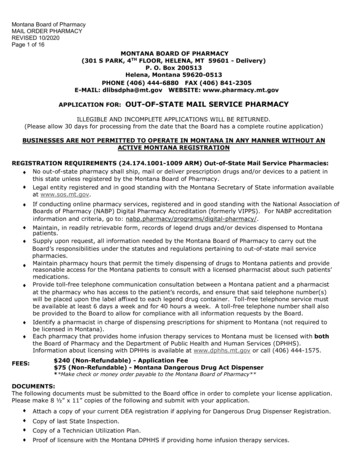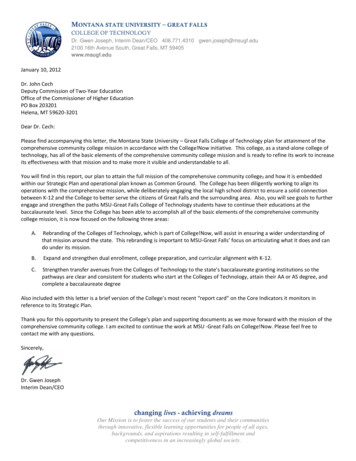
Transcription
MONTANA STATE UNIVERSITY – GREAT FALLSCOLLEGE OF TECHNOLOGYDr. Gwen Joseph, Interim Dean/CEO 406.771.4310 gwen.joseph@msugf.edu2100 16th Avenue South, Great Falls, MT 59405www.msugf.eduJanuary 10, 2012Dr. John CechDeputy Commission of Two-Year EducationOffice of the Commissioner of Higher EducationPO Box 203201Helena, MT 59620-3201Dear Dr. Cech:Please find accompanying this letter, the Montana State University – Great Falls College of Technology plan for attainment of thecomprehensive community college mission in accordance with the College!Now initiative. This college, as a stand-alone college oftechnology, has all of the basic elements of the comprehensive community college mission and is ready to refine its work to increaseits effectiveness with that mission and to make more it visible and understandable to all.You will find in this report, our plan to attain the full mission of the comprehensive community college, and how it is embeddedwithin our Strategic Plan and operational plan known as Common Ground. The College has been diligently working to align itsoperations with the comprehensive mission, while deliberately engaging the local high school district to ensure a solid connectionbetween K-12 and the College to better serve the citizens of Great Falls and the surrounding area. Also, you will see goals to furtherengage and strengthen the paths MSU-Great Falls College of Technology students have to continue their educations at thebaccalaureate level. Since the College has been able to accomplish all of the basic elements of the comprehensive communitycollege mission, it is now focused on the following three areas:A.Rebranding of the Colleges of Technology, which is part of College!Now, will assist in ensuring a wider understanding ofthat mission around the state. This rebranding is important to MSU-Great Falls’ focus on articulating what it does and cando under its mission.B.Expand and strengthen dual enrollment, college preparation, and curricular alignment with K-12.C.Strengthen transfer avenues from the Colleges of Technology to the state’s baccalaureate granting institutions so thepathways are clear and consistent for students who start at the Colleges of Technology, attain their AA or AS degree, andcomplete a baccalaureate degreeAlso included with this letter is a brief version of the College’s most recent “report card” on the Core Indicators it monitors inreference to its Strategic Plan.Thank you for this opportunity to present the College's plan and supporting documents as we move forward with the mission of thecomprehensive community college. I am excited to continue the work at MSU -Great Falls on College!Now. Please feel free tocontact me with any questions.Sincerely,Dr. Gwen JosephInterim Dean/CEOchanging lives - achieving dreamsOur Mission is to foster the success of our students and their communitiesthrough innovative, flexible learning opportunities for people of all ages,backgrounds, and aspirations resulting in self-fulfillment andcompetitiveness in an increasingly global society.
Mission Expansion PlanCollege!NowJanuary 2012
MSU-Great Falls College of Technology: changing lives – achieving dreams MissionExpansionMSU-Great Falls continues to demonstrate its commitment to the comprehensive community collegemission as envisioned for all of the state’s Colleges of Technology. MSU-Great Falls historically hasembraced and embodied all of the elements of the comprehensive community college mission. Our fourcore themes of Academic Preparation, Workforce Development, Transfer Preparation, andCommunity Development provide the institutional framework for our programming and services.As evidenced below, we took great strides in our strategic planning process to ensure that we: created avision, established a mission, and identified values that traditionally support a progressive comprehensivecommunity college environment.Vision: In the next decade, MSU – Great Falls will play a leading role in transforming the lives of ourstudents, their communities, and the economic prosperity of Montana by responding to learner andcommunity needs through the use of partnerships, innovation, outreach, and technology.Mission: Our Mission is to foster the success of our students and their communities through innovative,flexible learning opportunities for people of all ages, backgrounds, and aspirations resulting in self–fulfillment and competitiveness in an increasingly global society.Values: Accountability: we ensure our decisions are data-informed and grounded in the best interest ofour students and their communities. Integrity: we value civic responsibility, high academic standards, ethical practices, and thecourage to act. Lifelong Learning: we believe education is a lifelong necessity and commitment; we personifythis belief by engaging and reengaging students from all generations in learning opportunities. Respect: we value differences and treat others with civility, encouraging open and honestcommunication. Responsiveness: we recognize and act upon opportunities to be innovative, flexible, andadaptable to our students’ and communities’ needs. Student Success: we are dedicated to student success and achievement; we strive to meet theeducational needs of our students and their communities.Comprehensive Community College MissionMSU-Great Falls College of Technology’s 2009-2013 Strategic Plan, with its overarching strategicpriorities, guides our efforts and actions in the pursuit of realizing our vision and mission. The plan issimple, and closely aligns with both the strategic plan of the Board of Regents and the UniversitySystem’s two-year education agenda, College!Now. The plan currently includes four priorities thatillustrate ways in which we can improve our delivery of the comprehensive community college mission.Each priority guides the College’s divisions in a unified effort to move the College forward. Thesepriorities are:1. Increase the rate at which students succeed in developmental coursework (primarily Math andEnglish), enroll in and successfully complete their first college- level courses in the samedisciplines.2
MSU-Great Falls College of Technology: changing lives – achieving dreams MissionExpansion2. Increase the number of students participating in and completing programs that result in theirsuccessful transfer to a Bachelor degree program.3. Increase the number of adult students participating in and earning a post-secondary credential.4. Increase the number of high school students participating in early college activities leading tocollege credit.Common Ground: Operationalizing the Strategic PlanThe strategic plan calls for MSU-Great Falls to work closely with partners in education, business, andindustry to enable more students to succeed in achieving their educational goals. The plan is a livingdocument reviewed each year to ensure the college’s efforts are innovative, adaptable, and relevant toidentified needs. This provides a foundation for a better future for the students of MSU – Great Falls, itscommunities, and the state of Montana.MSU-Great Falls also employs an institutional operational plan, Common Ground, that focuses onspecific goals and tasks undertaken by the various units of the College to a achieve our strategic plangoals and performance targets. Common Ground is a campus-wide initiative designed to elevate ourstudents to a higher level of achievement by strengthening the 21st Century learning experience. To reachthese aspirations and continue our momentum, we must now strive to bring about deep change in thebeliefs, norms, and structures of interactions between faculty, staff, and students by: setting measureablegoals and targets; focusing on in-depth professional development; establishing cross-functional teams totackle major challenges; and cultivating a safe climate for innovation.GOAL 1: SET AND ACHIEVE INSTITUTIONAL AND STUDENT SUCCESS GOALSWe will establish clear, measureable goals for improved student success and institutional effectiveness.These will be communicated broadly and measured consistently.Task A. Establish a new indicator that directly measures students’ success through the analysis ofsuccessful course completion, looking at the percent of students who earned a C- or higher in allcoursework.Task B. Use historical data, comparative peer data, and aspirational targets, to establish FY12 goals forthe College’s Core Indicators of Institutional Effectiveness. Communicate these via a specialfocus IR newsletter during early fall term, with continued communication through a variety ofmodes (blurb in Weekly News, video screens, Facebook, etc.).Task C. Identify the “Top 10 Underperforming Courses” with the smallest percentage of successfulstudent completions, and the primary gatekeeper courses with below-average rate of studentsuccess (institutional average in FY10 is 77%), and establish multi-year goals for improvementin these rates.Task D. Create and maintain a SharePoint site where institutional reports (e.g., core indicator reports,enrollment reports, survey reports, etc.) can be shared with the campus community. InstitutionalResearch will also start a documentation process for all reports so that any data used in reportscan be replicated.3
MSU-Great Falls College of Technology: changing lives – achieving dreams MissionExpansionGOAL 2: “CLOSE THE LOOP” ON THE ASSESSMENT OF STUDENT LEARNINGWe will systematically align institutional/instructional expectations, instructional activities, and theassessment of student learning, and institutionalize a process for capturing and analyzing student learningdata.Task A. Finalize/verify the establishment of common student learning outcomes (course objectives) for allcourses at the College (e.g., all ANTH 100 courses have common outcomes regardless ofinstructor or modality of delivery).Task B. Identify and/or design common assessment protocols for measuring student learning on theestablished learning outcomes (e.g., all ANTH 100 courses would employ the same assessmentprotocols for measuring student achievement of the common learning outcomes within thatcourse).Task C. Utilizing an institutionally adopted format (e.g., Phase IV Form), create rubrics for assessing thevarious levels of student learning on common learning outcomes for every course and programoffered at the College.Task D. Research, identify, and employ a college-wide system for storing student learning outcomes dataand longitudinally tracking those data to guide instructional improvement and target neededinterventions to improve student learning and success.Task E. Implement the process for conducting assessments, recording student achievement of learningoutcomes, and reporting those results.GOAL 3: STRENGTHEN STUDENT SUPPORT SERVICES AND PROGRAMSWe will establish intrusive student support mechanisms that will: create social relationships for students;help students clarify aspirations and enhance their commitment; develop the “College Know-How” instudents; and help make college life feasible for our students.Task A. Catalyzed by the establishment of a new advising center, redesign the advising process so that itis intrusive, streamlined, and personalized. The new advising process should be designed toutilize all campus resources, including faculty, as well as be tied to a student early alert system.Task B. Building from the COLS 102 Pilot Course, design and implement a mandatory student successcourse, tied to orientation and advising, for all students new to the College. This course shouldinclude components modeled after best practices such as the development of an academic andcareer plan to be utilized in the advising process.Task C. Improve the “front door” experience through innovations including a mandatory, extended, andexpanded student orientation, tied to advising and the student success course that includes suchthings as orientation to placement testing, financial literacy education.4
MSU-Great Falls College of Technology: changing lives – achieving dreams MissionExpansionGOAL 4: ENHANCE AND STRENGTHEN THE LEARNING PROCESS THROUGHCURRICULAR AND PEDAGOGICAL REFORMSTeaching is central to our mission, and thus it plays the largest role in whether or not our studentssucceed. We will reform and innovate in those areas with the greatest need and potential for increasesstudent success.Task A. Building from current research, reform and redesign the developmental education offerings toincrease the percent of students who are successfully remediated for college-level courseworkand at the rate in which they succeed in this process.Task B. Implement enhanced instruction/ learning models and other reforms, including, but not limited toSupplemental Instruction, learning communities, paired courses, and/or contextualized learning,to increase the rate of student success in gatekeeper and “Top 10 Underperforming Courses.”Task C. Establish mechanisms for predictive analysis of student success and to target intervention. Thisincludes the establishment of a common grade reporting system, mandatory student attendancereporting/tracking, and frequent student progress feedback (e.g., quarterly grades or academicprogress reports).Task D. Increase student preparedness for online and technical courses through the development of asystematic means to evaluate incoming students’ basic computer skills, a remedial basiccomputer skills course, and by evaluating the current Introduction to Computer course (CAPP120) in order to modify its curricula based upon program needs.Task E. Research and develop a Certificate of General Studies credential and curriculum, and shepherd itthrough the approval process for implementation.Task F. Research and develop a certificate program or credential to recognize the completion of prerequisite coursework for Health Sciences Programs.GOAL 5: STRENGTHEN EXTERNAL LINKAGES WITH K12 AND UNIVERSITY PARTNERSWe will work to improve the relationships and interconnectivity between the College and our primarypartners in the K12 and four-year university sectors.Task A. K12 - through partnership with the Great Falls Public Schools, hire and deploy pathways advisorsto: offer college placement test orientation and testing in the high schools; assist with collegeand financial aid applications and literacy; and provide orientation and support services tocollege, college planning, and dual creditTask B. Universities - establish more formalized articulation agreements to provide opportunities forgeneral education students intending to transfer that lead them effectively into a program ofstudy early on.GOAL 6: IDENTIFY KEY POINTS OF SUCCESS AND CHALLENGE OUR STUDENTS FACEWe will establish interdisciplinary teams to track cohorts of entering students (first-time and transfers)along the continuum of initial engagement to student success to identify where students face irrevocablechallenges in their educational journey.5
MSU-Great Falls College of Technology: changing lives – achieving dreams MissionExpansionTask A. Utilizing AACC’s Voluntary Framework of Accountability (VFA), identify key success pointsalong the continuum of student success (e.g. completing developmental education, completingthe first college-level course, achieving 15, 30, etc. college credits). Create cohort data sets ofkey student types (e.g. pre-health students, students of color, transfer students, traditional andnon-traditional, etc.) and have teams follow their progress to identify areas where studentsstruggle.Task B. Taking the findings from above, make recommendations for improvements to services, processesor protocols to the appropriate individual or areas. Implement changes to improve studentoutcomes along the continuum of student success.Although not specifically delineated in our strategic plan or specified in Common Ground, MSU-GreatFalls is ready to move forward with the rebranding and renaming effort that will further support all of ourinitiatives and goals. To our campus, this is the biggest area of work in establishing our institution as acomprehensive community college.Goals for 20112 and BeyondAs MSU-Great Falls continue to move forward with realizing the comprehensive community collegemission, we will continue to focus on the following three goals:A. Rebranding of the Colleges of Technology, which is part of College!Now will assist in ensuring awider understanding of that mission around the state. This rebranding is important to MSU-GreatFalls’ focus on articulating what it does and can do under its mission.B. Expand and strengthen dual enrollment, college preparation, and curricular alignment with K-12.C. Strengthen transfer avenues from the Colleges of Technology to the state’s baccalaureate grantinginstitutions so the pathways are clear and consistent for students who start at the Colleges ofTechnology, attain their AA or AS degree, and complete a baccalaureate degree.Challenges and Resources:The expanding and strengthen dual enrollment, college preparation, and curricular alignment with K-12are challenging but promising in that our Superintendent of Public Instruction has led from her office withthe adoption of the Common Core Standards that are being widely accepted in many other states as well.The Standards lend themselves well to a smooth transition to college, and over time we believe they willassist us in curricular alignment that translates to fewer students leaving high school and needingremediation in college in our state. Our local work in dual enrollment and especially with our newPathways Advisor initiative is part of our innovative plan to encourage higher college-going rates in ourcommunity, lower remediation rates, and increase the number of students leaving high school withcollege credit as well.To bolster the confidence our constituency has with the realization of the comprehensive communitycollege mission, transfer avenues and clear connections with baccalaureate degrees are needed. As wecontinue to focus on this locally, we know wider support and interest is needed within the state’sbaccalaureate-granting institutions such that students transferring from the Colleges of Technology with6
MSU-Great Falls College of Technology: changing lives – achieving dreams MissionExpansionan AA or AS degree have a smooth transition. Many of the technical barriers that have existed in thisarena have already been removed or mitigated through Common Course Numbering and the creation ofan application transfer vehicle between Registrar’s Offices. Working on understanding and removingcurricular barriers are our next steps.Resources needed to accomplish what the MSU-Great Falls community has identified include: Funding to assist with rebranding elements (website redesign, signage, logo redesign, updatingstationary, marketing materials, business cards, badges, etc.). Human resources to work on items A and B above, including release time for faculty and stafftime needed to work through curricular alignment with secondary school partners as well asuniversity system partners.Strategic Plan Results: Mission Expansion In response to the need to increase success in developmental course work, the Department of Artsand Sciences was restructured and renamed (Summer 2011) to more clearly reflect its mission.The newly formed Division of Developmental Education and Transfer oversees the generaleducation courses at the College and now has a stronger focus on success in developmentaleducation courses as well as oversight of the Learning Center. In May of 2011, MSU – Great Falls initiated the movement to create a common and clear pricingstrategy for dual credit/dual enrollment. At their August meeting, the Montana Board of Regentsadopted a common application process and pricing structure for dual credit/dual enrollmentstudents at Montana’s Colleges of Technology, community Colleges, MSU – Northern and UMWestern. In close collaboration with Great Falls Public Schools, MSU – Great Falls and the districtestablished an innovative agreement to allow home school students in Great Falls to access dualcredit/dual enrollment courses at the College at the discounted price reserved for students in thepublic schools. To enhance and strengthen the transfer process, the College has researched and designed aCertificate of General Studies that will go before the Montana Board of Regents for formalapproval in March 2012. In efforts to strengthen pathways for students intending to transfer for a bachelors program to theaffiliated campuses of Montana State University, MSU – Great Falls accomplished severalmilestones. The College entered into an innovative, new partnership with MSU – Northern thatincluded the creation of a shared academic advisor and transfer coordinator. This position hasbeen funded by MSU – Bozeman for three years. MSU – Great Falls hosted a summit in conjunction with MSU Billings faculty, staff, andadministrators to explore new opportunities for transfer programming. MSU – Great Falls presented to MSU University Council and conducted site visits to the collegesat Montana State University to build new partnerships around transfer programming. MSU – Great Falls, recognizing the need to support the many adult veterans who are pursuingtheir educational dreams at the College, established the Veterans Center that serves militaryveterans from all branches. Great Falls Public Schools Adult Basic Literacy Education, which serves both high school ageand adult learners, has seen a significant increase in numbers of attendees and numbers of GED7
MSU-Great Falls College of Technology: changing lives – achieving dreams MissionExpansiongraduates after moving to the MSU – Great Falls campus. A record number of their GEDcompleters have enrolled in the College. The Montana Institute on Educational Technology (MIET), which serves the professionaldevelopment needs of K12 teachers, began in 2003 and is now a week-long annual event. The2011 MIET featured 116 Educational Technology classes and keynotes from both Apple andMicrosoft. In a culmination of several years of conversation and planning, MSU-Great Falls and the GreatFalls Public Schools entered into another agreement to share two full-time Pathways Advisorpositions that are designed as the vehicle to increase the college-going rate of youth in the GreatFalls Public Schools. The two Pathways Advisors were hired and started their work in the fall of2011, with half their time spent physically in their respective high schools and half spent workingwith adult populations through the ABLE program. The three main work areas outlined are:Dual enrollment, College Preparation (including prevention of college remediation), and CareerPlanning. The partnership is in place for three years to allow time for assessment of theaccomplishment of the goals of the positions.Please see the following document for MSU-Great Falls most recent “report card” on the Core Indicatorsit monitors in reference to its Strategic Plan.8
MSU - Great FallsPerformance Report Card - 2010/2011AY 10/11GoalGradeCIOverall 0%15.0%4.057%45%23.2%14.9%N/ABABAA33445A-26129%68% 14.4594%94%23830%69% 16.0592%98%ABBCAB88991011B 8017%31%767420%41%75ABCA12121314B 59%74%77%71%61%72%73%79%BAAB6677A-/B 0.2%79618981588660.7%13892198219678DDDDB215151616D 4568288032%3686847536%AAADB articipationCredit-Bearing Full-Time Equivalent (FTE) EnrollmentCredit-Bearing HeadcountRegional Market Penetration Rates (Credit)Student SuccessRetention/Persistence - FTFT StudentsRetention/Persistence - FTPT StudentsGraduation Rates - FTFT Students within 3 yearsGraduation Rates - FTPT Students within 5 yearsDemonstration of 8 AbilitiesWorkforce Development (Core Theme 1)Workforce Degree Production (# of degrees)Workforce Degree Production (Rate)In-Field Job Placement RatesGraduate EarningsLicensure & Certification Pass RatesEmployer Satisfaction with GraduatesTransfer Preparation (Core Theme 2)Transfer Degree Production (# of degrees)Transfer Degree Production (Rate)Transfer Rates to 4-year schoolsPerformance After Transfer (MUS Graduates)Academic Preparation (Core Theme 3)Success of Students in Remedial Courses (Math)Success of Students in Remedial Courses (Writing)Success in Subsequent Coursework (Math)Success in Subsequent Coursework (Writing)Community Development (Core Theme 4)Regional Market Penetration Rates (PCE)Participation (PCE Unduplicate Headcount)Participation (PCE Enrollments)Business & Industry Training (Participants)Business & Industry Training (Businesses)Increase Transfer Student Participation (SP 1)Increase Transfer Student FTEIncrease Transfer Student HeadcountIncrease Transfer Student DegreesIncrease Transfer Student % of Student PopulationIncrease Adult Student Participation (SP 2)Increase Adult Student FTEIncrease Adult Student HeadcountIncrease Adult Student DegreesIncrease Adult Student % of Student PopulationIncrease High School Student Participation (SP 3)Increase HIgh School Student FTEIncrease HIgh School Student HeadcountIncrease HIgh School Student % of Student Population
Comprehensive Community College Mission MSU-Great Falls College of Technology's 2009-2013 Strategic Plan, with its overarching strategic priorities, guides our efforts and actions in the pursuit of realizing our vision and mission. The plan is simple, and closely aligns with both the strategic plan of the Board of Regents and the University
